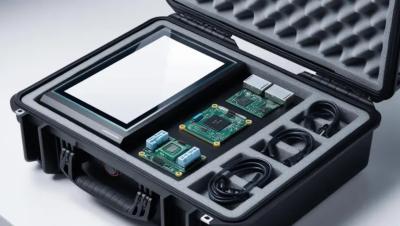MicroSolid Printing pioneer VueReal is going to unveil several new technologies and products at CES, as the company gets ready for microLED display commercialization. VueReal wants companies to take advantage of the unique properties of microLED displays (mainly the customized production process and the high transparency and high brightness) and this year it will focus on new applications that can be enabled only by microLEDs.
First up, VueReal is launching new microLED Design Reference Kits to enable product designers to buy display samples and integrate into new designs. The first kit will provide microLED-powered lighting panels. These resemble OLED lighting panels - area lighting that is uniform. But unlike OLEDs, microLEDs will provide high brightness, long lifetime, and reduced costs. These are basically monochrome simple displays, and VueReal will offer either in native colour (R, G, B) or phosphor coated (white, red, amber).
The second reference kit will offer passive matrix and active matrix (LTPS) microLED displays. These displays will be either 3.5" or 10" in size, and will offer high transparency (up to 85%). Beyond the transparency, these displays can be laminated on surfaces and are very thin, thus enabling very nice designs.
The third reference kit will offer microdisplays. There will be two kinds of displays, the first, produced in collaboration with RIT, will be produced on a PM backplane and will offer a low cost monochrome solution for AR. The second microdisplay kit will be produced on a CMOS backplane, these will also be monochrome, but using optics these can be combined to create a full color solution.
VueReal will start selling and shipping the new reference kit right after CES, and we will soon share more details.
Beyond these reference kits, the company will be showing new use cases and applications based on its MicroSolid Printing platform. One example is the integration of solar panels and displays - basically the idea is to produce the microLED display on top of a solar panel (polysilicone panel, in the first generation). As the microLED display itself is highly transparent (even at high density) this can be highly efficient. The company's tests show that even at a density similar to the Apple Watch display (326 PPI), such a display could power a wearable product without any need for charging (this depends on the use pattern, of course). Other design ideas on show will be automotive digital mirrors with microLED placed on top, and a special transparent window display to show information for people outside the car (for example in RoboTaxi scenario, to show the taxi's user name and data) and also for the people sitting inside the vehicle (information display).
Another new technology that will be unveiled is called AdaptiveVue, which is a combination of a transparent microLED display with an electrochromic display. This will enable the user to control the transparency at the pixel level, thus creating a unique display that can either be partially transparent, or even use the electrochromic platform to enable dark pixels (which cannot be done with normal microLEDs as they are either transparent or emitting).


